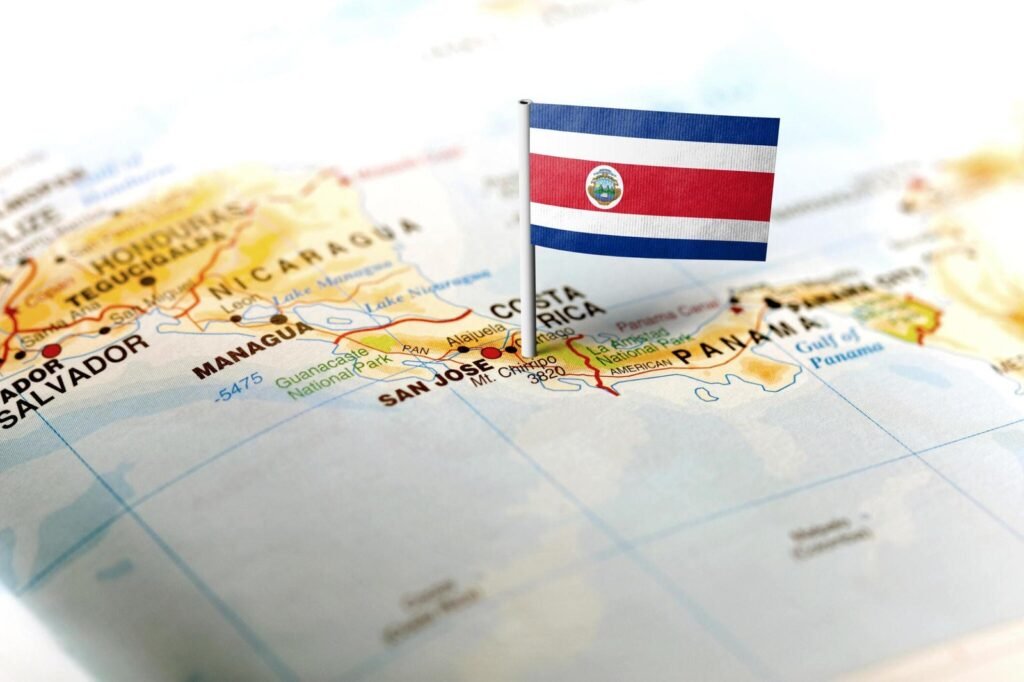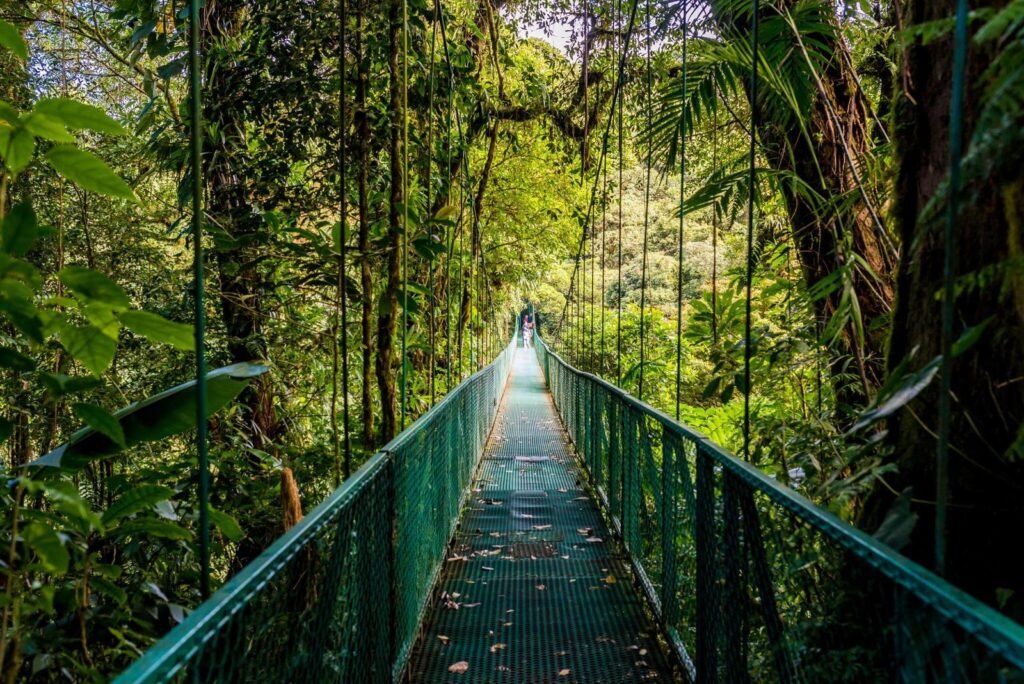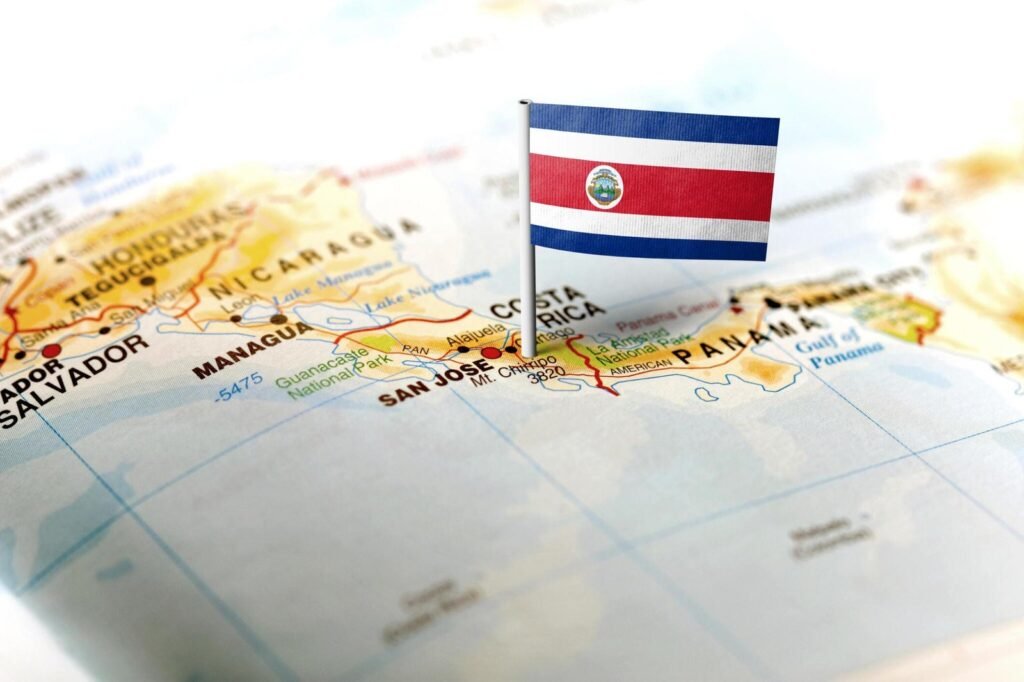Ever dreamt of waking up to the sound of monkeys howling and colorful birds singing in a lush rainforest teeming with exotic wildlife? Welcome to Costa Rica, the Central American gem that beckons adventurers with its breathtaking landscapes, rich biodiversity, and endless opportunities for exploration.
Picture yourself hiking up active volcanoes or white-water rafting through volcanic canyons. Imagine strolling along pristine beaches, where the turquoise waters of the Pacific and Caribbean Seas lap at your feet. And don’t forget to keep an eye out for elusive sloths and playful monkeys swinging through the canopy of a cloud forest.
But Costa Rica is more than just postcard-perfect scenery. It’s a vibrant tapestry of culture, where colorful festivals, lively music, and mouthwatering cuisine bursting with fresh tropical flavors await. Embrace the “pura vida” spirit – a philosophy of cherishing simplicity, expressing gratitude, and finding joy in every moment.
Whether you’re a nature enthusiast, adrenaline seeker, or simply looking to unwind in paradise, Costa Rica offers an unforgettable experience. From the misty cloud forests of Monteverde to the bustling streets of San Jose, every corner of this captivating country promises adventure, beauty, and memories that will last a lifetime.
Get ready to embark on a journey of discovery and wonder. Costa Rica awaits – where every day is an opportunity to live pura vida!
Costa Rica Map: Navigating the diverse landscape
Embark on an Adventure: Your Costa Rican map is your ticket to unparalleled beauty and excitement. From vibrant rainforests echoing with the calls of exotic birds to sun-kissed beaches lapped by crystal-clear turquoise waters, Costa Rica offers unforgettable experiences for every traveler.
Seamless Navigation: Nestled between Nicaragua and Panama, Costa Rica boasts stunning coastlines along the Pacific Ocean and the Caribbean Sea. Conquer volcanic peaks like Arenal, Poás, or Rincón de la Vieja, all conveniently marked on your map, and be rewarded with breathtaking vistas.
Discover Paradise: Explore iconic national parks like Manuel Antonio, where playful monkeys swing through the lush rainforest canopy. Glide through the tranquil canals of Tortuguero, a haven for nesting sea turtles, or trek beneath the ancient rainforest canopy of Corcovado National Park.
Tailored Adventures: Whether you seek relaxation or thrills, Costa Rica delivers. Your map guides you to world-renowned beaches like Tamarindo, offering epic surfing waves, and Manuel Antonio, with its vibrant Afro-Caribbean rhythms perfect for soaking up the laid-back atmosphere.
Exploration Made Easy: Navigate major highways and scenic routes with ease, stopping at charming local villages along the way. International airports in San Jose and Liberia provide gateways to adventure, while regional airports offer access to remote corners of paradise. Grab your map and let the adventure begin – Costa Rica awaits!

Costa Rica Flag: Symbolism and national pride
the Costa Rican flag is a potent symbol of the nation’s essence, past, and principles. Its design and symbolism reflect the country’s natural beauty, historical journey, and unyielding spirit. As Costa Ricans hoist their flag aloft, they pay homage to their heritage, exult in their present, and motivate future generations to champion peace, freedom, and solidarity.
The Costa Rican flag stands as more than just a piece of cloth; it’s a beacon of the nation’s identity, history, and values. Its striking design and profound symbolism evoke a deep sense of national pride and unity among Costa Ricans.
Design Elements:
Comprising five horizontal stripes in blue, white, and red, each color carries significant meaning. The blue stripes represent the sky, symbolizing opportunities, perseverance, and the country’s Pacific and Caribbean coasts. The white stripe embodies peace, wisdom, and happiness. Meanwhile, the red stripes signify the blood shed for freedom and the warmth of the Costa Rican people.
Historical Significance:
Dating back to 1848 amidst political turmoil in Central America, the flag’s design was inspired by the French tricolor, embodying the ideals of liberty, equality, and fraternity. Throughout history, it has served as a rallying point during times of struggle and celebration, reflecting the resilience and determination of Costa Ricans.
National Pride:
The flag is more than a mere emblem; it’s a source of immense pride and unity. Whether soaring high during Independence Day festivities or adorning government edifices, schools, and residences nationwide, it serves as a constant reminder of Costa Rica’s values and accomplishments.

Costa Rica Currency: Managing finances effectively
Planning a trip to Costa Rica? Understanding the local currency, the Costa Rican Colón (CRC), is essential for a smooth and worry-free adventure. This guide equips you with the knowledge to manage your finances effectively during your Costa Rican escape.
The Colón: A Breakdown
- Symbol: ₡
- Denominations: Colones come in bills (₡1,000, ₡2,000, ₡5,000, ₡10,000, ₡20,000, ₡50,000) and coins (₡50, ₡100, ₡500).
Exchange Rates:
- Fluctuate, so research current rates before your trip. Consider using a reliable currency converter app for easy on-the-go reference.
Cash vs. Card:
- While credit cards are widely accepted in tourist areas, carrying some Colones is crucial for smaller purchases (think souvenirs, street food, bus tickets – expect to pay around ₡1,000-₡2,000) and local markets. Bargaining is not customary in most stores, but at some souvenir markets, you might be able to negotiate a slightly lower price.
Tipping:
- Tipping is not mandatory, but a small gratuity (10-15%) is always appreciated for good service in restaurants. Round up taxi fares or leave a few extra Colones.
Where to Exchange Currency:
- International airports offer exchange services, but rates might not be the most favorable.
- Banks and authorized currency exchange offices generally provide better rates.
- ATMs are readily available in major towns, dispensing Colones with your debit card (be sure to inform your bank about your travels to avoid blocked cards).
Staying Secure:
- Carry only what you need for the day.
- Utilize ATMs in well-lit, public areas.
- Consider a money belt or secure pouch for storing cash and cards.
Bonus Tip:
- Familiarize yourself with common Costa Rican phrases related to money, like “cuánto cuesta” (how much does it cost?) and “gracias” (thank you). A little goes a long way!
By following these tips, you can confidently manage your finances and focus on creating unforgettable memories in Costa Rica!

Weather in Costa Rica: Climate insights for a comfortable trip
Planning a trip to Costa Rica? Understanding the country’s diverse climate is key to ensuring a comfortable and enjoyable adventure. Costa Rica boasts a tropical paradise experience, with varied topography offering everything from lush rainforests to cool mountain ranges and stunning Pacific and Caribbean coastlines. Here’s what you need to know to prepare for your journey:
Dry Season vs. Wet Season:
Costa Rica experiences two primary seasons: the dry season (known locally as verano) and the wet season (invierno). The dry season typically runs from December to April, offering sunny skies with lower humidity, ideal for beach vacations and outdoor activities. Average highs range from the mid-80s Fahrenheit (29°C) during the day to the mid-70s Fahrenheit (24°C) at night.
The wet season, from May to November, brings frequent afternoon showers and lush green landscapes. Temperatures remain warm, with average highs in the low to mid-80s Fahrenheit (27-29°C). This season is perfect for exploring rainforests and enjoying the vibrant colors of nature, with the added benefit of encountering fewer crowds.
Regional Variations:
While the overall climate is tropical, regional variations exist. Coastal areas tend to be hot and humid year-round, with temperatures ranging from the high 70s to mid-90s Fahrenheit (25-35°C). Inland regions, such as the Central Valley and the Monteverde Cloud Forest Reserve, boast cooler temperatures due to higher elevations, making them popular destinations for escaping the heat. Temperatures here can range from the mid-70s Fahrenheit (24°C) during the day to the low 60s Fahrenheit (16°C) at night.
Packing Essentials:
Regardless of the season, pack lightweight, breathable clothing, including shorts, T-shirts, and swimwear for coastal areas. Don’t forget a waterproof jacket or poncho for the wet season, along with sturdy hiking shoes for exploring rainforests and muddy trails. Sunscreen, a wide-brimmed hat, and insect repellent are must-haves year-round.
For cooler highland areas, pack a light sweater and long pants, especially if planning nighttime excursions or hikes.
Weather Considerations for Activities:
Plan your activities based on the weather. The dry season is ideal for snorkeling, surfing, and zip-lining adventures, while the wet season offers excellent opportunities for white-water rafting through rainforests swollen with rainwater, wildlife spotting amidst the vibrant flora and fauna, and rejuvenating in natural hot springs.
Embrace the Unexpected:
Keep in mind that Costa Rica’s weather can be unpredictable, with microclimates varying from one region to another. For instance, the Caribbean coast tends to be wetter than the Pacific coast. Flexibility is key, so consider having a mix of indoor and outdoor activities planned to accommodate any weather changes.
By understanding Costa Rica’s climate and packing accordingly, you’ll be well-prepared to embrace all the adventures this stunning country has to offer, rain or shine. Get ready for an unforgettable journey filled with natural wonders, vibrant culture, and warm hospitality!

Airports in Costa Rica: Convenient entry points and transportation hubs
Whether you’re arriving in Costa Rica for a beach vacation, eco-adventure, or cultural exploration, the country’s well-connected network of airports ensures convenient entry points and transportation hubs to kickstart your journey. With various transportation options available, navigating Costa Rica’s diverse landscapes and attractions has never been easier. Get ready to embark on an unforgettable adventure in this tropical paradise!
For travelers planning a journey to Costa Rica, understanding the country’s airports is crucial for seamless entry and convenient transportation throughout your stay. Costa Rica boasts several international and regional airports strategically located across the country, serving as gateways to its diverse landscapes and vibrant culture. Here’s everything you need to know about airports in Costa Rica:
Juan Santamaría International Airport (SJO): Located in Alajuela, just outside the capital city of San José, Juan Santamaría International Airport is the primary entry point for international travelers visiting Costa Rica. Offering a wide range of services and facilities, including car rental agencies, currency exchange counters, restaurants, and shops, SJO provides easy access to popular destinations such as the Central Valley, Arenal Volcano, and the Pacific coast.
Daniel Oduber Quirós International Airport (LIR): Situated in Liberia, Guanacaste, Daniel Oduber Quirós International Airport serves as the main airport for travelers visiting the northwestern region of Costa Rica. With direct flights from major cities in the United States, Canada, and Europe, LIR is a convenient entry point for visitors exploring the stunning beaches, national parks, and eco-tourism adventures of Guanacaste province and beyond.
Tobías Bolaños International Airport (SYQ): Located in Pavas, a suburb of San José, Tobías Bolaños International Airport primarily handles domestic and regional flights to neighboring countries in Central America. Despite its smaller size compared to SJO, SYQ offers convenient access to popular destinations within Costa Rica, including Manuel Antonio, Monteverde, and Tortuguero.
Regional Airports: Costa Rica features several regional airports scattered across the country, facilitating travel to remote and off-the-beaten-path destinations. These airports, such as Quepos (XQP), Tamarindo (TNO), and Tortuguero (TTQ), offer domestic flights operated by local airlines, providing quick and efficient transportation to various regions of Costa Rica.
Transportation Options: Upon arrival at any of Costa Rica’s airports, travelers can easily access ground transportation options, including taxis, shuttles, rental cars, and private transfers. Taxis are readily available outside the terminals, while car rental agencies offer the flexibility to explore the country at your own pace. Shuttle services and private transfers can also be arranged in advance for hassle-free transportation to your desired destination.

Costa Rica Capital: Discovering San Jose’s cultural riches
San Jose, Costa Rica’s capital city, is a vibrant and dynamic destination teeming with cultural riches waiting to be discovered. From its historic landmarks and artistic treasures to its culinary delights and lively festivals, San Jose offers travelers a captivating glimpse into the soul of Costa Rica. So, pack your bags and embark on an unforgettable journey to explore the cultural heart of this beautiful country.
explore the vibrant capital city of San Jose, a cultural hub brimming with history, art, and culinary delights. As the political, economic, and cultural center of the country, San Jose offers travelers a fascinating glimpse into Costa Rican life and heritage. Here’s what you need to know to uncover the cultural riches of Costa Rica’s capital:
Historical Significance:
San Jose, founded in 1738, has evolved into a bustling metropolis blending colonial charm with modern dynamism. Wander through its streets lined with historic buildings, bustling markets, and lively plazas, each bearing witness to the city’s rich history.
Art and Architecture:
Immerse yourself in San Jose’s vibrant arts scene with visits to its numerous museums, galleries, and theaters. Explore the Museo Nacional de Costa Rica to discover pre-Columbian artifacts and colonial art, or be mesmerized by a captivating performance at the opulent Teatro Nacional.
Culinary Delights:
Indulge in San Jose’s eclectic culinary scene, where traditional Costa Rican flavors like gallo pinto (rice and beans) and casado (a typical Costa Rican dish) blend harmoniously with international cuisines offered in the city’s diverse array of restaurants.
Local Markets and Craftsmanship:
Experience the vibrant colors and flavors of Costa Rican culture at San Jose’s bustling markets. Visit the Mercado Central to immerse yourself in the sights, sounds, and aromas of traditional Costa Rican life, or explore the Mercado de Artesanías for unique handcrafted treasures and gifts.
Cultural Events and Festivals:
Immerse yourself in San Jose’s lively cultural scene by attending festivals, concerts, or cultural events. From the vibrant parades of the Fiestas de Zapote to the electrifying rhythms of the International Arts Festival, San Jose offers numerous opportunities to celebrate Costa Rican culture and heritage.
Beyond the City Limits:
San Jose’s central location makes it an ideal base for exploring other parts of Costa Rica. Take a day trip to witness the awe-inspiring power of Poas Volcano, delve into the lush rainforest canopy of Monteverde Cloud Forest Reserve, or embark on a journey to a coffee plantation to discover the secrets behind Costa Rica’s world-renowned brew.
Safe and Sound:
San Jose is a relatively safe city for tourists, but as always, be aware of your surroundings, especially in crowded areas.
Airlines serving Costa Rica: Top carriers and routes
Costa Rica boasts excellent air connectivity, making it easily accessible from various points across the globe. Whether you’re flying in from North America, Europe, or Latin America, numerous airlines offer convenient routes to kickstart your Costa Rican adventure. Here’s a breakdown of some of the top airlines serving Costa Rica, categorized by region:
North American Airlines:
- American Airlines: Operates numerous flights from Miami (MIA), Dallas/Fort Worth (DFW), and Charlotte (CLT), connecting travelers across the United States and beyond. (mostly narrow-body aircraft)
- Delta Air Lines: Provides non-stop flights from Atlanta (ATL), offering easy access from the southeastern United States with connections from other parts of the country. (mix of narrow-body and wide-body aircraft)
- United Airlines: Offers direct flights from Houston (IAH) and Newark (EWR), catering to travelers from the southern and eastern regions of the United States. (mix of narrow-body and wide-body aircraft)
- Southwest Airlines: A popular choice for budget-conscious travelers, offering direct flights from several U.S. cities including Houston (HOU), Fort Lauderdale (FLL), and Baltimore/Washington (BWI). (mostly narrow-body aircraft)
- JetBlue Airways: Serves Costa Rica from its focus cities in the northeastern and southeastern United States, such as New York (JFK), Boston (BOS), and Fort Lauderdale (FLL), offering non-stop flights and connections. (mostly narrow-body aircraft)
- Spirit Airlines: Provides budget-friendly options for travelers seeking low-cost fares, with flights from Fort Lauderdale (FLL) and Orlando (MCO). (mostly narrow-body aircraft)
- Air Canada: Offers non-stop flights from Toronto (YYZ), ensuring convenient access for travelers from Canada and connecting flights from other North American cities. (mix of narrow-body and wide-body aircraft)
Latin American Airlines:
- Copa Airlines: A major carrier in Latin America, Copa Airlines connects Costa Rica with numerous destinations across Central and South America through its hub in Panama City (PTY). (mix of narrow-body and wide-body aircraft)
- Avianca: The national airline of Colombia, operating flights from Bogota (BOG) and San Salvador (SAL), providing connections for travelers coming from South America and beyond. (mix of narrow-body and wide-body aircraft)
- Volaris: A Mexican low-cost carrier, offering affordable flights from Mexico City (MEX) with connections from other parts of North America. (mostly narrow-body aircraft)
With this comprehensive overview of airlines and routes, you can plan your Costa Rican adventure with ease. Soak up the sun on pristine beaches, delve into the rainforest’s rich biodiversity, or explore the vibrant culture – Costa Rica awaits!
Visa Requirements: Clearing up entry regulations
Visa Requirements for Costa Rica
Planning a trip to Costa Rica? Understanding visa requirements is essential for a smooth and hassle-free entry. Here’s a concise guide to help you navigate the entry regulations:
Visa-Free Entry:
The good news is that citizens of many countries can enjoy visa-free entry for tourism purposes for up to 90 days. This includes the United States, Canada, European Union member states, and most Central and South American countries, along with citizens from certain Asian and Middle Eastern countries. However, it’s always recommended to double-check the specific requirements for your nationality before traveling. For comprehensive information, you can visit the official Costa Rican immigration website here.
Tourist Visa Extension:
If you crave more time to explore Costa Rica’s wonders, you can apply for a tourist visa extension at the immigration office (Dirección General de Migración y Extranjería) within the country. This extension allows you an additional 90 days to soak up the sun on pristine beaches, delve into the rainforests’ rich biodiversity, or explore the vibrant culture. (Be aware that extension fees may apply).
Documentation Required:
Upon arrival, have your valid passport ready for inspection, with at least six months of validity beyond your intended stay. Proof of onward or return travel, such as a return flight ticket or itinerary, is usually required to demonstrate your exit plans within the permitted time frame.
Visa Requirements for Specific Situations:
Planning to work, study, or volunteer in Costa Rica? Different visa requirements apply in such cases. Consult the nearest Costa Rican embassy or consulate to obtain the necessary information and documentation for your specific situation.
By understanding these visa requirements, you can ensure a smooth entry into Costa Rica and get ready to experience the adventure, relaxation, and cultural immersion this beautiful country offers!

Language in Costa Rica: Embracing Spanish for immersive experiences
Language in Costa Rica is predominantly Spanish, and it serves as the country’s official language. Spanish is spoken by the vast majority of the population and is used in government, education, media, and everyday communication.
Costa Rican Spanish, often referred to as “tico Spanish” (derived from the local term “tico” for a Costa Rican), has its own unique characteristics, including distinct pronunciation, vocabulary, and idiomatic expressions. While the Spanish spoken in Costa Rica is generally understandable to speakers of other dialects, visitors may encounter regional variations and colloquialisms during their stay.
In addition to Spanish, there are also several indigenous languages spoken by various ethnic groups, such as Bribri, Cabécar, and Ngäbere. However, these languages are not as widely spoken as Spanish and are primarily used within indigenous communities.
While English is not an official language in Costa Rica, it is widely understood, especially in tourist areas, hotels, restaurants, and among younger generations who learn it in school. Visitors who speak English should generally have little difficulty communicating in popular tourist destinations.
Overall, while knowledge of Spanish is not strictly necessary for travelers to Costa Rica, it can greatly enhance the experience, facilitate interactions with locals, and provide a deeper understanding of the country’s culture and traditions. Visitors who make an effort to learn some basic Spanish phrases will likely find their trip more rewarding and enjoyable.
Embracing the Spanish language is the key to unlocking truly immersive experiences during your visit to Costa Rica. As the official language, Spanish is woven into the country’s vibrant culture, rich history, and the daily lives of its friendly people. While learning a new language can present challenges, the rewards of deeper connections and a more meaningful Costa Rican adventure are well worth the effort. Here’s how Spanish can elevate your trip:
Connecting with Locals:
Spanish is the primary way to connect with Costa Ricans on a deeper level. Whether you’re interacting with hotel staff, ordering a casado (a typical Costa Rican dish) at a local restaurant, or bargaining at a market, speaking Spanish allows you to forge genuine connections and gain insights into the local way of life.
Cultural Understanding:
Language is a window into a culture’s soul. By learning Spanish, you gain a deeper appreciation of Costa Rica’s rich cultural heritage. From understanding traditional expressions to appreciating the nuances of local music and literature, Spanish opens doors to a world of cultural immersion.
Navigating Everyday Life:
While many Costa Ricans in tourist areas speak English, venturing off the beaten path often requires some Spanish proficiency. Knowing Spanish empowers you to navigate everyday situations with confidence, whether you’re asking for directions, shopping at local markets, or seeking assistance in rural areas.
Enhancing Travel Experiences:
Speaking Spanish unlocks a richer travel experience. Whether you’re participating in a cooking class, joining a guided tour through the rainforest canopy, or volunteering with local communities, Spanish enables you to interact more meaningfully and gain deeper insights into the places you visit.
Personal Growth:
Learning a new language is a journey of personal growth and self-discovery. By immersing yourself in Spanish during your time in Costa Rica, you not only enhance your communication skills but also broaden your horizons, challenge yourself, and gain a sense of accomplishment.
Tips for Language Learning:
- Take advantage of language learning apps or online resources before your trip to familiarize yourself with basic Spanish phrases and vocabulary.
- Don’t be afraid to practice speaking Spanish with locals during your travels, even if you make mistakes. Most people appreciate the effort and are happy to help you improve.
- Immerse yourself in the language by watching Spanish-language movies or TV shows, listening to music, and reading books or newspapers in Spanish, even if you can only understand bits and pieces at first.
By embracing the Spanish language during your visit to Costa Rica, you’ll not only enrich your travel experiences but also gain a deeper appreciation for the country’s culture, people, and way of life. So, ¡prepárate para sumergirte en la aventura costarricense! (Get ready to dive into the Costa Rican adventure!)
Costa Rica Cities: Highlights of vibrant urban centers
Exploring the vibrant urban centers of Costa Rica offers travelers a glimpse into the country’s diverse culture, history, and modern lifestyle. From bustling capital cities to charming provincial towns, each city has its own unique charm and attractions. Here are some highlights of the top cities to visit in Costa Rica:
- San José: As the capital and largest city of Costa Rica, San José is a bustling metropolis that serves as the country’s cultural and economic hub. Visitors can explore historic landmarks such as the National Theater, the Pre-Columbian Gold Museum, and the Metropolitan Cathedral. The city also boasts vibrant markets, bustling plazas, and a lively arts and culinary scene.
- Liberia: Located in the Guanacaste province, Liberia is known as the “White City” due to its whitewashed adobe buildings. The city serves as the gateway to popular tourist destinations such as the Rincon de la Vieja National Park and the Papagayo Peninsula. Visitors can explore the city’s colonial architecture, visit local markets, and experience traditional Costa Rican cuisine.
- Heredia: Known as the “City of Flowers,” Heredia is renowned for its beautiful parks, gardens, and colonial architecture. Visitors can explore landmarks such as the Basilica of the Immaculate Conception, the Central Park, and the Heredia Museum. The city is also a hub for coffee production, with many coffee plantations offering tours and tastings.
- Alajuela: Located just outside San José, Alajuela is known for its laid-back atmosphere and historic charm. Visitors can explore landmarks such as the Juan Santamaría Museum, the Central Park, and the Alajuela Cathedral. The city is also a gateway to the Poás Volcano National Park and the La Paz Waterfall Gardens.
- Cartago: As the former capital of Costa Rica, Cartago is steeped in history and tradition. Visitors can explore landmarks such as the Basilica of Our Lady of the Angels, the Cartago Ruins, and the Lankester Botanical Garden. The city also offers hiking opportunities in the nearby Irazú Volcano National Park.
Each of these cities offers a unique glimpse into Costa Rica’s culture, history, and natural beauty, making them must-visit destinations for travelers exploring this vibrant country.
best time to visit Costa Rica
Ultimately, the best time to visit Costa Rica depends on your personal preferences and the activities you’re interested in. If you prefer sunny skies and are willing to contend with larger crowds and higher prices, the dry season may be ideal for you. On the other hand, if you enjoy lush green landscapes, wildlife viewing, and saving money, the green season or shoulder seasons may be more suitable. Regardless of when you visit, Costa Rica’s natural beauty and diverse attractions are sure to leave you with unforgettable memories.
The best time to visit Costa Rica depends on your preferences for weather, activities, and crowd levels. Here’s a breakdown of the different seasons and what they offer:
- Dry Season (December to April):
- This period is characterized by sunny days and lower humidity, making it ideal for beach vacations and outdoor activities.
- You can enjoy activities like snorkeling, surfing, zip-lining, and exploring national parks with fewer chances of rain.
- However, this is also the peak tourist season, so popular destinations may be crowded, and prices for accommodations and tours may be higher.
- Green Season (May to November):
- Also known as the wet or rainy season, this period sees more frequent rain showers, particularly in the afternoons.
- Despite the rain, mornings are usually sunny and activities can still be enjoyed, albeit with the occasional interruption.
- The lush green landscapes, fewer crowds, and lower prices for accommodations and tours make this a favorable time for budget travelers and nature enthusiasts.
- The rain also brings wildlife out, making it a great time for birdwatching and observing lush vegetation.
- Shoulder Seasons (May, June, September, October):
- These months offer a transition between the dry and wet seasons, providing a balance of good weather, fewer crowds, and lower prices.
- You can enjoy pleasant weather with occasional showers, making it a great time for outdoor activities and exploring both coastal and inland areas.
FAQ
Is Costa Rica in Asia or Europe?
Costa Rica isn’t just beautiful, it’s geographically blessed! Nestled in Central America, Costa Rica borders Nicaragua to the north and Panama to the south. The Caribbean Sea bathes its eastern shores, while the Pacific Ocean graces the west. This unique location creates a country with a rich blend of ecosystems, from lush rainforests to stunning coastlines.
Do I need a visa for Costa Rica?
Whether or not you need a visa for Costa Rica depends on your nationality. Citizens of many countries, including the United States, Canada, and most European Union member states, can enjoy visa-free entry for tourism purposes for up to 90 days. However, it’s always recommended to double-check the specific requirements for your nationality before traveling. For comprehensive information, you can Visit the official Costa Rican immigration website.
What is Costa Rica best known for?
Costa Rica is a treasure trove for nature enthusiasts and adventure seekers alike. Here are some of the highlights that make Costa Rica a world-renowned destination:
Thriving Rainforests: Explore the vibrant rainforests teeming with exotic wildlife, from playful monkeys and colorful birds to elusive jaguars and sloths. Immerse yourself in the verdant landscapes and discover the incredible biodiversity Costa Rica is famous for.
Active Volcanoes: Witness the awe-inspiring power of nature with Costa Rica’s active volcanoes. Hike up cloud-piercing peaks for breathtaking panoramic views or visit volcanic hot springs for a relaxing soak.
Secluded Beaches: Unwind on pristine beaches with crystal-clear waters and soft sand. Whether you’re seeking relaxation under the warm sun or adventure with surfing and diving, Costa Rica’s coastline caters to all preferences.
Adventure Activities: Get your adrenaline pumping with Costa Rica’s exciting adventure options! Soar through the rainforest canopy on zip-lines, navigate thrilling white-water rapids, or challenge yourself with a trek up a volcano.
Sustainable Practices and Eco-Tourism: Costa Rica is a leader in sustainable practices and eco-tourism. Many lodges and tour operators prioritize preserving the environment while offering unforgettable experiences for visitors.
What is the capital of Costa Rica?
San José, the vibrant capital and largest city of Costa Rica, pulsates with culture, history, and a modern atmosphere. As the country’s political and economic hub, San José offers a glimpse into Costa Rican life.
Cultural and Historical Significance: Explore San José’s museums, including the renowned Pre-Columbian Gold Museum, to delve into Costa Rica’s rich history and indigenous heritage. The National Theater, a stunning example of neoclassical architecture, is a must-see landmark.
Lively Atmosphere: Immerse yourself in the city’s lively atmosphere. Explore bustling Central Market for local crafts, souvenirs, and fresh produce, or savor delicious Costa Rican cuisine at welcoming restaurants.
Transportation Hub: San José serves as a convenient transportation hub for exploring other parts of Costa Rica. Many tours and day trips depart from the city, making it a great base for venturing out into the country’s natural wonders.
Safety Tips: While Costa Rica is generally a safe country, it’s always wise to exercise caution in crowded areas and take common-sense precautions as you would anywhere you travel.
conclusion
Costa Rica’s natural beauty, rich culture, and iconic attractions, travelers can gain a deeper appreciation for this stunning destination. Whether it’s exploring lush rainforests, relaxing on secluded beaches, or immersing oneself in the vibrant culture of San José, Costa Rica offers something for every type of traveler.
Additionally, the guide emphasizes the importance of language and cultural understanding, encouraging travelers to embrace Spanish for more immersive experiences and meaningful connections with locals.
Overall, with careful planning and preparation using the information provided in this guide, travelers can embark on an unforgettable journey to Costa Rica, filled with adventure, relaxation, and cultural discovery. So, pack your bags and get ready to explore all that Costa Rica has to offer!



